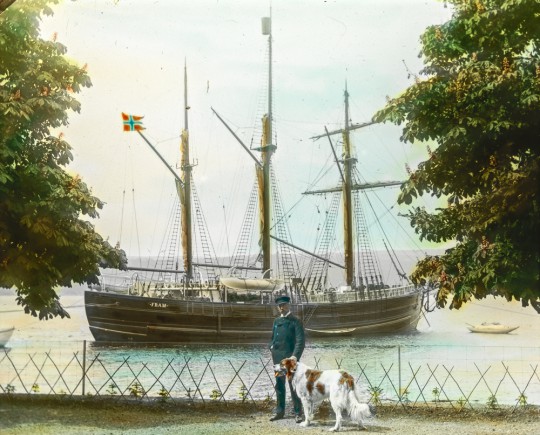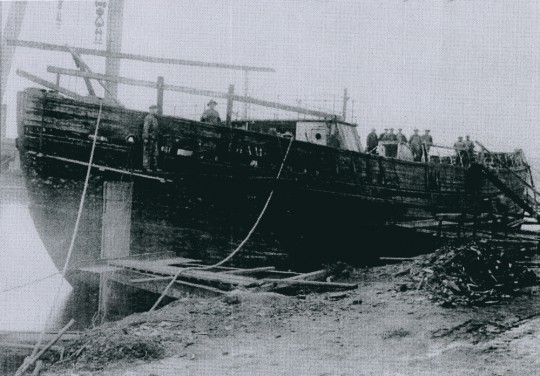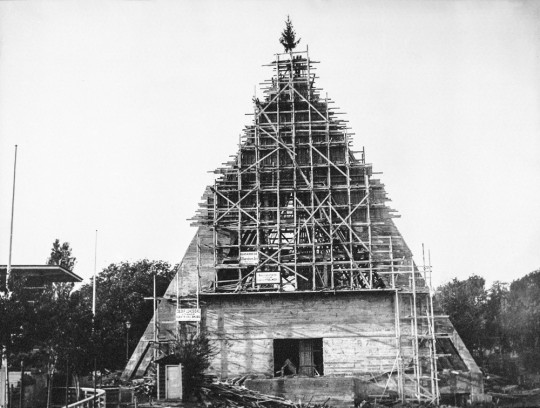OM MUSEET
Museets historie
Polfarernes tidsepoke
Som verdens mest berømte polarskute, er Fram et symbol på Norges viktige rolle i polfarernes tidsepoke.

Fridtjof Nansen, Otto Sverdrup og Roald Amundsen benyttet seg av polarskipet FRAM da de la ut på sine ekspedisjoner til Arktis og Antarktis. Skipet er designet og bygget av Colin Archer på Fridtjof Nansens bestilling. Men det er ikke en selvfølge at verdens sterkeste treskute eksisterer i dag...

Amundsen poserer foran Fram utenfor hjemmet sitt i Svartskog

Fram before restoration in Framnæs Mekaniske Verksted in Sandefjord
Fram kom tilbake fra Buenos Aires i 1914 og lå fortøyd ved Horten, utsatt for vær og vind. Etter første verdenskrig arbeidet en rekke komiteer med å bevare polarskipet, men uten resultater. Prosjektets sterkeste forkjemper, Otto Sverdrup, ble valgt til formann i Framkomiteen i 1925. Han kjempet utrettelig videre sammen med komiteens medlemmer og flere andre nøkkelpersoner i årevis. I 1929 ble Fram slept til et verft, Framnæs Mekaniske Verksted i Sandefjord. Her ble skipet under Otto Sverdrups tilsyn reparert med utmerket støtte fra konsul Lars Christensen.
I 1930 ble Fram endelig restaurert til den tilstanden den var i under Otto Sverdrups ekspedisjon til øyene nordvest på Grønland. Otto Sverdrup døde samme år som Fram deltok på et stort spillested i Trondheim. Det tok lang tid før hun endelig fikk et permanent hjem. I 1934 tilbød Oslo Arkitektforening å holde en arkitektkonkurranse for å tegne et bygg for det ærede fartøyet. Det ble sendt inn 60 bidrag og vinneren ble arkitekten Bjarne Tøien med sitt bidrag «Saga». Fram ble dratt inn i sitt nye hjem av en elektrisk motor. Skipet beveget seg en centimeter per minutt. 20. mai 1936 ble Frammuseet endelig åpnet. Både Hans Majestet Kong Haakon VII og Hans Kongelige Høyhet Kronprins Olav var til stede. Et nasjonalt monument var endelig på plass.

Bygningen har fått den monumentale formen den er kjent for i dag
I dag inneholder Frammuseet utstillinger av de mest kjente seilasene av global historisk betydning. Museets midtpunkt er selvsagt verdens sterkeste treskip, polarskipet Fram. Publikum kan gå om bord og ta en titt rundt i lugarer, salonger, lasterom og maskinrom.

Frammuseet i dag.
Gjøa-bygget, som er knyttet til Fram med en underjordisk tunnel, huser Gjøa, det første skipet som har navigeret gjennom hele Nordvestpassasjen. Hun sto utenfor Fram-museet i førti år før hun endelig fikk sitt eget vernebygg i 2013. Før det ble hun stilt ut på en strand i Golden Gate Park i San Francisco.


Bygningene er like i form og farge.
Det er helt nye historiske utstillinger om ekspedisjonene til Gjøa og Maud, av flyene N24 og N25 samt av luftskipet Norge, John Franklins legendariske ekspedisjon og Henry Larsens og Eivind Astrups.

Antall besøkende har variert fra 18 000 året det åpnet ned til 5000 under andre verdenskrig 1940-1945. Etter krigen økte antall besøkende årlig, og i 2024 oppnådde vi dagens rekord på over 400 000 besøkende! Den 5. august 1999 nådde antallet besøkende totalt 10 millioner.

Velkommen til et større og bedre Frammuseum!


